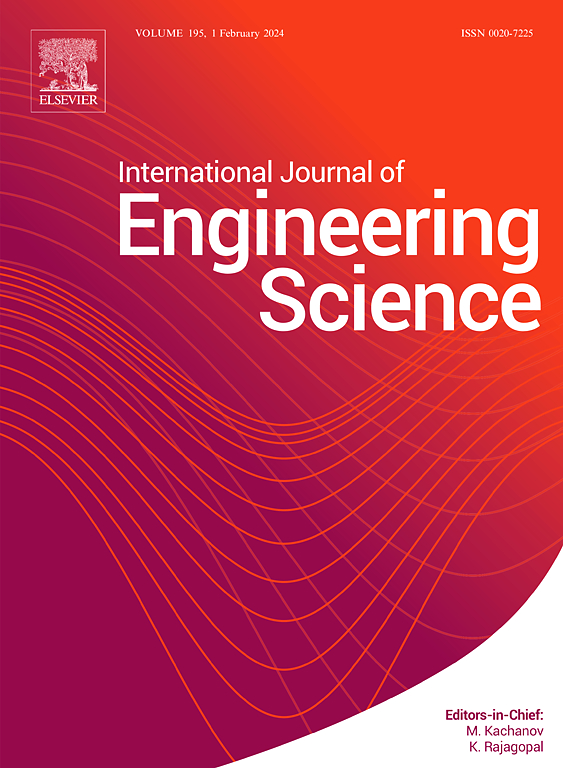Analytical solutions for predicting shear stresses in axially graded tapered beams
IF 5.7
1区 工程技术
Q1 ENGINEERING, MULTIDISCIPLINARY
International Journal of Engineering Science
Pub Date : 2025-05-17
DOI:10.1016/j.ijengsci.2025.104292
引用次数: 0
Abstract
This study investigates the state of stress in slender elastic cylinders with variable cross-sections and axially graded material properties. In contrast to prismatic homogeneous cylinders, the continuous variation of cross-sectional dimensions and material properties along the axis of the cylinder produces additional shear stress distributions within the cross-sections. This work sheds the light on how these stresses depend on the axial gradation of both geometry and material. The analytical approach in this paper is based on partial differential equations derived in a recent work that describe the stress state in tapered inhomogeneous elastic cylinders. A new analytical solution is presented for rectangular cross-sectioned tapered cylinders with axially graded material properties, subjected to external loads at the ends. By examining this paradigmatic case, the combined effects of taper and axial material gradation on the shear stresses across the cylinder’s cross-sections are discussed, highlighting the limitations of solutions obtained by approximating the geometric and material properties as piecewise constant along the cylinder’s axis. Numerical examples, including comparisons with benchmark solutions from a finite element method, are provided to support the analytical findings of the study. In addition to the theoretical insights, the analytical solutions developed here hold practical value in a wide range of engineering applications, such as aerospace structures, mechanical components, biomedical implants, energy harvesters, vibration control systems, and smart sensors for structural health monitoring.
预测轴向渐变锥形梁剪应力的解析解
本文研究了具有变截面和轴向梯度材料性能的细长弹性圆柱体的应力状态。与棱柱状均匀圆柱体相比,横截面尺寸和材料性能沿圆柱体轴线的连续变化会在横截面内产生额外的剪切应力分布。这项工作揭示了这些应力如何依赖于几何和材料的轴向梯度。本文的分析方法是基于在最近的工作中导出的偏微分方程,该方程描述了锥形非均匀弹性圆柱体的应力状态。提出了具有轴向梯度材料性能的矩形截面锥形圆柱体在端部受外载荷作用时的解析解。通过研究这一典型案例,讨论了锥度和轴向材料梯度对圆柱体横截面剪切应力的综合影响,突出了通过将几何和材料特性近似为沿圆柱体轴的分段常数获得的解的局限性。数值算例,包括与有限元方法的基准解的比较,提供了支持研究的分析结果。除了理论见解之外,这里开发的分析解决方案在广泛的工程应用中具有实用价值,例如航空航天结构,机械部件,生物医学植入物,能量采集器,振动控制系统和用于结构健康监测的智能传感器。
本文章由计算机程序翻译,如有差异,请以英文原文为准。
求助全文
约1分钟内获得全文
求助全文
来源期刊

International Journal of Engineering Science
工程技术-工程:综合
CiteScore
11.80
自引率
16.70%
发文量
86
审稿时长
45 days
期刊介绍:
The International Journal of Engineering Science is not limited to a specific aspect of science and engineering but is instead devoted to a wide range of subfields in the engineering sciences. While it encourages a broad spectrum of contribution in the engineering sciences, its core interest lies in issues concerning material modeling and response. Articles of interdisciplinary nature are particularly welcome.
The primary goal of the new editors is to maintain high quality of publications. There will be a commitment to expediting the time taken for the publication of the papers. The articles that are sent for reviews will have names of the authors deleted with a view towards enhancing the objectivity and fairness of the review process.
Articles that are devoted to the purely mathematical aspects without a discussion of the physical implications of the results or the consideration of specific examples are discouraged. Articles concerning material science should not be limited merely to a description and recording of observations but should contain theoretical or quantitative discussion of the results.
 求助内容:
求助内容: 应助结果提醒方式:
应助结果提醒方式:


